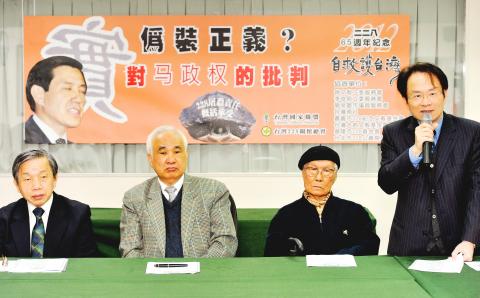President Ma Ying-jeou (馬英九) has failed to deliver on his pledge to find the truth about the 228 Massacre and its perpetrators, civic groups and victims’ families said yesterday.
Civic groups plan to highlight Ma’s disappointing record on transitional justice in his first term with two marches to commemorate the 65th anniversary of the massacre, group representatives told a press conference.
In a violent suppression of anti-government uprisings that began on Feb. 28, 1947 — two years after the end of Japanese colonial rule — Chinese Nationalist Party (KMT) troops killed between 18,000 and 30,000 people, the majority of them Taiwanese and including many of the island’s leaders and intellectuals.

Photo: Chien Rung-fong, Taipei Times
Ma said at the opening ceremony of the renovated National 228 Memorial Museum on Feb. 28 last year that the government would continue to unearth the truth of the incident to help future generations understand the historical facts of the massacre and to make sure such incidents never happen again, Taiwan 228 Care Association chairman Chang Yen-hsien (張炎憲) said.
However, Ma and his administration had failed to uncover any truths for the victims’ families in the past four years, he said.
Neither had anyone involved in the incident stepped forward to offer an apology to the victims and the public, he added.
This is why an alliance of civic groups has organized marches to raise awareness of the massacre and Ma’s negligence, Taiwan Nation Alliance convener Yao Chia-wen (姚嘉文) said.
The first march is scheduled for Taipei on Feb. 28 under the theme “self-salvation to protect Taiwan,” and it will also protest against Ma’s “pro-China” policies, which the group says are putting Taiwan’s sovereignty in jeopardy.
A second march is planned for Chiayi City on March 25.
More than 50 memorial services, most of which have been organized by Taiwan’s Presbyterian Church, and other events would be held nationwide to commemorate the massacre, the 228 Memorial Foundation said.
Ma is scheduled to attend a memorial ceremony organized by the central government, to be held at Taipei’s 228 Peace Park on the afternoon of Feb. 28.

Taiwan is to commence mass production of the Tien Kung (天弓, “Sky Bow”) III, IV and V missiles by the second quarter of this year if the legislature approves the government’s NT$1.25 trillion (US$39.78 billion) special defense budget, an official said yesterday. Commenting on condition of anonymity, a defense official with knowledge of the matter said that the advanced systems are expected to provide crucial capabilities against ballistic and cruise missiles for the proposed “T-Dome,” an advanced, multi-layered air defense network. The Tien Kung III is an air defense missile with a maximum interception altitude of 35km. The Tien Kung IV and V

The disruption of 941 flights in and out of Taiwan due to China’s large-scale military exercises was no accident, but rather the result of a “quasi-blockade” used to simulate creating the air and sea routes needed for an amphibious landing, a military expert said. The disruptions occurred on Tuesday and lasted about 10 hours as China conducted live-fire drills in the Taiwan Strait. The Civil Aviation Administration (CAA) said the exercises affected 857 international flights and 84 domestic flights, affecting more than 100,000 travelers. Su Tzu-yun (蘇紫雲), a research fellow at the government-sponsored Institute for National Defense and Security Research, said the air

A strong continental cold air mass is to bring pollutants to Taiwan from tomorrow, the Ministry of Environment said today, as it issued an “orange” air quality alert for most of the country. All of Taiwan except for Hualien and Taitung counties is to be under an “orange” air quality alert tomorrow, indicating air quality that is unhealthy for sensitive groups. In China, areas from Shandong to Shanghai have been enveloped in haze since Saturday, the ministry said in a news release. Yesterday, hourly concentrations of PM2.5 in these areas ranged from 65 to 160 micrograms per cubic meter (mg/m³), and pollutants were

Taiwan’s armed forces have established response protocols for a wide range of sudden contingencies, including the “Wan Chun Plan” to protect the head of state, the Ministry of Defense (MND) said today. After US President Donald Trump on Saturday launched a series of airstrikes in Venezuela and kidnapped Venezuelan President Nicolas Maduro, concerns have been raised as to whether China would launch a similar “decapitation strike” on Taiwan. The armed forces regularly coordinate with relevant agencies and practice drills to ensure preparedness for a wide range of scenarios, Vice Minister of National Defense Hsu Szu-chien (徐斯儉) told reporters before a